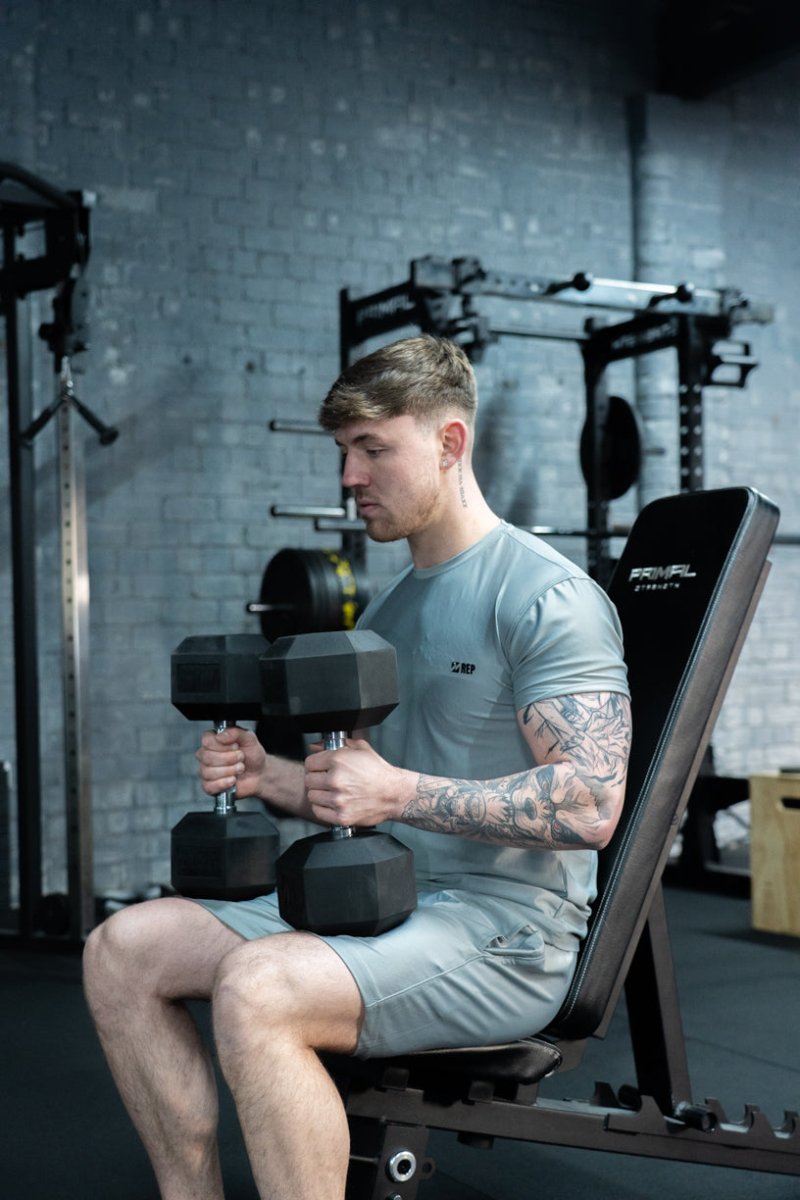
Top Exercises for Biceps To Build Bigger Arms Fast
Let’s be real – the top exercises for biceps are a must if you want bigger arms. Whether you're flexing in the mirror or pulling heavy deadlifts, strong arms are a gym staple. In this guide, we’re breaking down the top exercises for biceps that pack on size and strength. These moves hit every angle of the muscle and can be added to any training plan.
Why Biceps Matter More Than You Think

Your biceps aren’t just for show. They’re one of the most functional muscles in your upper body, involved in nearly every pulling movement you do – from rows and pulldowns to everyday tasks like carrying shopping bags or picking things up. They stabilise your shoulders, protect your elbow joint, and boost your grip strength too. When combined with back and bicep exercises, they become a powerhouse for both aesthetics and athletic performance.
Well-developed biceps help improve posture, reduce the risk of injury during upper-body training, and make compound lifts like pull-ups, barbell rows, and deadlifts much more efficient. And let's be honest, there’s nothing wrong with wanting arms that pop in a T-shirt.
Plus, building your arms can:
-
Boost overall upper-body strength
-
Improve posture
-
Help with compound lifts like rows and pull-ups
1. Dumbbell Bicep Curl
This one’s a classic for a reason. Dumbbell curls are a staple in almost every program because they offer pure isolation of the biceps. You’re able to fully control the weight, improve symmetry between your arms, and build serious definition. It’s a great move to master early on, especially if you’re just starting out in the gym.
How to do it:
-
Stand tall with a dumbbell in each hand.
-
Keep your elbows close to your torso and palms facing forward.
-
Curl both arms up at the same time or alternate them, squeezing at the top.
-
Lower slowly to maximise time-under-tension.
Pro tip: Try alternating arms for more focus and to reduce fatigue in longer sets.
If you’re new to strength training, this is a solid move to include in your routine. Our full Beginner Gym Workout guide breaks down other key exercises to get you started strong.
2. Top Exercises for Biceps: Hammer Curl
Looking for great bicep exercises that also target the forearms? Hammer curls are your go-to. They hit the brachialis – the muscle that sits underneath your biceps. Strengthening this muscle not only increases your overall arm size but helps your biceps pop more by pushing them up and out. Hammer curls also engage your forearms, making them a powerful tool for total arm development.
They’re perfect for breaking plateaus and adding variety to your curl routine.
How to do it:
-
Hold dumbbells with a neutral grip (palms facing each other).
-
Keep your elbows close to your sides.
-
Curl up like you're swinging a hammer, focusing on a full range of motion.
-
Control the descent to avoid using momentum.
Pro tip: Use a slower eccentric (lowering) phase to really target the brachialis.
Want a program that includes hammer curls in a full upper-body routine? Our Back and Biceps Workout Exercises blog has you covered.
3. Top Exercises for Biceps: Preacher Curl
This movement locks in your arms, making it nearly impossible to swing or cheat. Preacher curls isolate the biceps and are great for beginners and advanced lifters alike. By anchoring your upper arms against the pad, you take other muscles out of the equation and force your biceps to do all the work.
They’re particularly good for targeting the lower portion of the bicep, giving you that full, rounded look.
How to do it:
-
Sit at a preacher bench with your chest against the pad.
-
Hold an EZ bar or dumbbell with an underhand grip.
-
Curl the weight up slowly, squeezing hard at the top.
-
Lower under control to feel the stretch in your biceps.
Pro tip: Don’t go too heavy – focus on form and feeling the muscle contract.
4. Concentration Curl
You want that peak? This curl isolates the long head of your biceps for that mountain-top flex. It’s a slower, more focused movement that builds shape and definition rather than sheer size.
Doing concentration curls forces you to use strict form, which makes it a favourite for those working on mind-muscle connection.
How to do it:
-
Sit down on a bench, with your feet flat and legs apart.
-
Rest your elbow on the inside of your thigh.
-
Curl the dumbbell slowly, keeping your upper arm still.
-
Squeeze hard at the top and lower with control.
Bonus: Great for isolating each arm and spotting strength imbalances.
5. Chin-Ups
Yeah, chin-ups aren’t just for your back. They’re one of the best back and bicep exercises you can do with your bodyweight. Chin-ups target the biceps heavily due to the underhand grip, while still smashing your lats and upper back.
Plus, they help build functional strength and can translate directly to better performance in other pulling exercises.

How to do it:
-
Grab a pull-up bar with an underhand grip, hands shoulder-width apart.
-
Start from a dead hang and pull your chest up to the bar.
-
Lower back down slowly without swinging.
Pro tip: If you can’t do a full chin-up yet, use resistance bands or an assisted machine to build strength.
Want more on this? Check out our Back and Biceps Workout Exercises blog.
6. Top Exercises for Biceps: Cable Bicep Curl
Cables provide constant tension, which helps build serious size and endurance. This variation is amazing for hitting the biceps throughout the entire range of motion – especially the peak contraction at the top.
You can easily switch grips or attachments (like a rope, straight bar, or cambered bar) to target different parts of the bicep.
How to do it:
-
Stand in front of a low pulley machine.
-
Attach a straight bar or rope and grab it with an underhand grip.
-
Keep your elbows tight to your sides and curl the bar toward your shoulders.
-
Pause and squeeze, then lower with control.
Pro tip: Don’t let the weights rest between reps – constant tension equals serious gains.
This is one of those dumbbell bicep exercises that hits differently with cables and is ideal for finishers.
7. Top Exercises for Biceps: Incline Dumbbell Curl
Stretch and lengthen the biceps for max growth. Incline curls are excellent for targeting the long head of the biceps, which helps build that taller, more defined bicep peak.
Sitting on an incline bench puts your arms behind your body, which increases the range of motion and maximises the stretch at the bottom of the curl.
How to do it:
-
Sit on an incline bench set to 45–60 degrees.
-
Hold a dumbbell in each hand, arms hanging down fully.
-
Keep your elbows in place and curl both arms up.
-
Squeeze at the top, then lower all the way down.
Pro tip: Use lighter weights for better control and range.
Programming Tips for Bigger Arms
Want to get the most out of your biceps training? It’s not just about doing curls – it’s about smart programming. To make real gains, you should train your biceps 2–3 times a week. This gives them enough volume to grow without overtraining. Recovery days in between are essential.
Make sure you're using a mix of heavy sets in the 6–8 rep range to build strength, and lighter, high-rep sets (12–15 reps) to flood the muscle with blood and build endurance. This balance hits both fast- and slow-twitch muscle fibres, which is key for hypertrophy.
And don’t forget your triceps. They actually make up about two-thirds of your upper arm, so skipping them can seriously limit your arm gains. Incorporate compound and isolation movements like close-grip bench press or tricep dips to round out your routine.
-
Train biceps 2–3 times a week
-
Mix heavy sets (6–8 reps) with pump work (12–15 reps)
-
Don’t neglect your triceps – they make up most of your upper arm

Recovery and Nutrition
You can train like a beast, but without recovery and proper nutrition, your results will stall. Recovery isn’t just about resting – it’s an active part of the muscle-building process. Aim to get 7–9 hours of quality sleep each night. This is when your body repairs muscle tissue and balances hormones like testosterone and growth hormone.
Hydration is often overlooked but plays a huge role in recovery. Muscles are around 75% water, so staying hydrated helps with nutrient delivery, joint lubrication, and even muscle fullness. Aim for 2–3 litres a day, especially around your workouts.
When it comes to food, your focus should be on protein, complex carbs, and healthy fats. Protein is essential – shoot for 1.6–2.2g per kg of bodyweight daily. Combine that with carbs to fuel your workouts and help with recovery, plus healthy fats to support hormone levels.
Don’t rely solely on supplements, but a quality whey protein shake post-workout can make hitting your protein targets easier. Creatine monohydrate is also well-researched and effective for increasing strength and muscle mass. For more science-backed supplementation tips, check out Examine.com.
If you’re training hard and want a more dynamic approach, mixing in functional movements from our Upper Body Weight Exercises for Women guide can boost your mobility, endurance, and total-body strength.
Don’t just train harder – recover smarter.
Bicep Exercises: Final Flex
Training biceps isn’t just about aesthetics – it boosts your strength, confidence, and overall performance. With these top exercises for biceps, you’ve got everything you need to build arms that do the talking.
Add a few of these to your next session, stay consistent, and trust the process.
Oh, and if you’re repping hard, do it in style. Check out REP’s latest drop – made for gym-goers who don’t skip arm day.
Top Exercises for Biceps: FAQs
1. How long does it take to see visible bicep growth?
With consistent training and proper nutrition, most people start seeing noticeable bicep gains in 6–8 weeks. Beginners may see faster results due to “newbie gains.”
2. Should I train biceps on their own or with other muscle groups?
Biceps are often trained alongside back, but they can also be trained solo or paired with triceps for an arm-focused session. It depends on your overall split.
3. Can I train biceps every day for faster growth?
No – biceps need time to recover. Training them every day can lead to overtraining and injury. Stick to 2–3 times per week.
4. What’s the best rep range for growing biceps?
A mix works best. Use 6–8 reps for strength and 10–15 reps for hypertrophy. Variety keeps the muscle adapting.
5. How important is grip strength for bicep exercises?
Very. Weak grip limits your ability to lift heavier weights or control tempo. Strengthening your grip can directly improve bicep performance.


